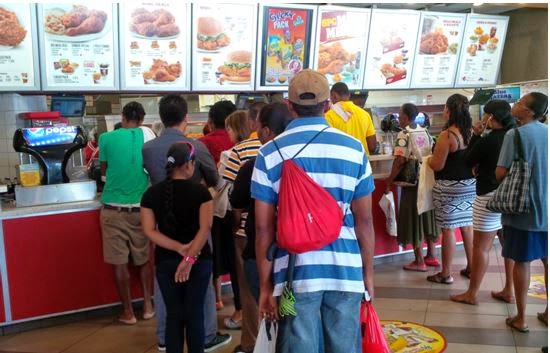 |
| Figure 1. Showing Persons Utilizing the Woodford Square At Midday (Photograph, taken by Sybastian Manners, February 20, 2015) |
 |
| Figure 2. Showing Patrons Enjoying the Night Life at Shakers, Ariapita Avenue (Photograph taken by Rachel Mckenzie on begalf of Sybastian Manner February 21, 2015. |
The photos above show two different types of spaces. While a public space is seen in figure one, a private space is seen in figure two. In our visits to the city we observed that those who were most frequently found enjoying public spaces (such as the one on Woodford Square) seemed to be persons of the working class. These persons included street sweepers, garbage collectors, fast food employees and taxi drivers. We observed very few persons in suits or crisply ironed shirts and ties in these areas. On the contrary while socialising on the Ariapita Avenue we noticed that most of the persons 'liming' on the avenue seemed to be of the middle class and high class.
We believe that several factors contribute to this polarisation in the use of public space. These factors include issues relating to time, a fear of crime, the state of public spaces and economic issues. Firtsly one factor which influences the use of public space is what Sybastian refers to as the 'corporate net'. The corporate net refers to the restrictions imposed on those who work in the service sectors. The capital driven economy which is an attribute of the postmodern city creates a rigid environment that adversely affects how individuals experience time and space. On average, eight hours of productivity is required of each employee with an hour break in which most choose to have lunch or do personal business in the capital or more frequently both. This really reduces the capacity for one to really experience each day outside of the task ascribed by the job description. As such many persons who get a chance to enjoy the public spaces are persons who work in less rigid environments such as in the informal sector (taxi drivers).
Furthermore, Mycoo (2008) stated that there is a "mounting evidence of state failure to provide basic state function such as...security for citizens". She believes that this is one of the key factors which has lent to the rise of gated communities in Trinidad. We believe that many persons of a high social status do not utilise public spaces because they do not believe that they are very safe. In the past many robberies and shootings have taken place in the vicinity of Public spaces in broad daylight. In October 2013, the Trinidad Newsday reported that persons 'liming' on the Brian Lara Promenade scattered in fear when two men were shot dead in a drive by shooting. This took place at 11:00 am on October 12th, 2014.
Furthermore, many persons do not use public spaces as they are seen by many as unsanitary places. Such places are often littered by the public as well as they are the homes of many vagrants. This has a significant effect on the health and livability of these places. This is an issue not only in Port of Spain but in other cities in the Caribbean. In an article entitled "Simply Beautiful..or Paradise Gone Down the Toilet?" in the St. Lucian Star newspaper, Toni Nicholas lamented at the way in wish the Derek Walcott Square, a public space in St. Lucia was kept. He stated, "in the middle of the kiosk inside the square lay a vagrant fast asleep, oblivious of the curious visitors desperately trying to photograph the venue...There was litter under the park benches and empty bottles everywhere. "
 |
| Photograph of A Vagrant Sleeping in the Derek Walcot Square ( Nicholas 2014) |
Lastly, some persons are excluded from certain spaces because of their financial status. Places such as the Shakers restaurant on the avenue clearly cater for persons of a high social status. Many of the working class poor cannot afford the expensive delicacies on these menus and so do not frequent such places. On the contrary many of the middle class enjoy such places which are often well secured and which helps to reinforce the reality that they have high positions on the social ladder.
References
"Two Men Shot". 2014. Newsday, October 14. Accessed March 30. 2015. http://www.newsday.co.tt/crime_and_court/0,184998.html
Nicholas, Toni. "Simply Beautiful..or Paradise Gone Down the Toilet?" The Star Newspaper, November,22. Accessed march 30. http://stluciastar.com/simply-beautiful-or-paradise-gone-down-the-toilet/
http://myelearning.sta.uwi.edu/file.php/25346/mycoo_2006_Trinidad_gated_communities.pdf






